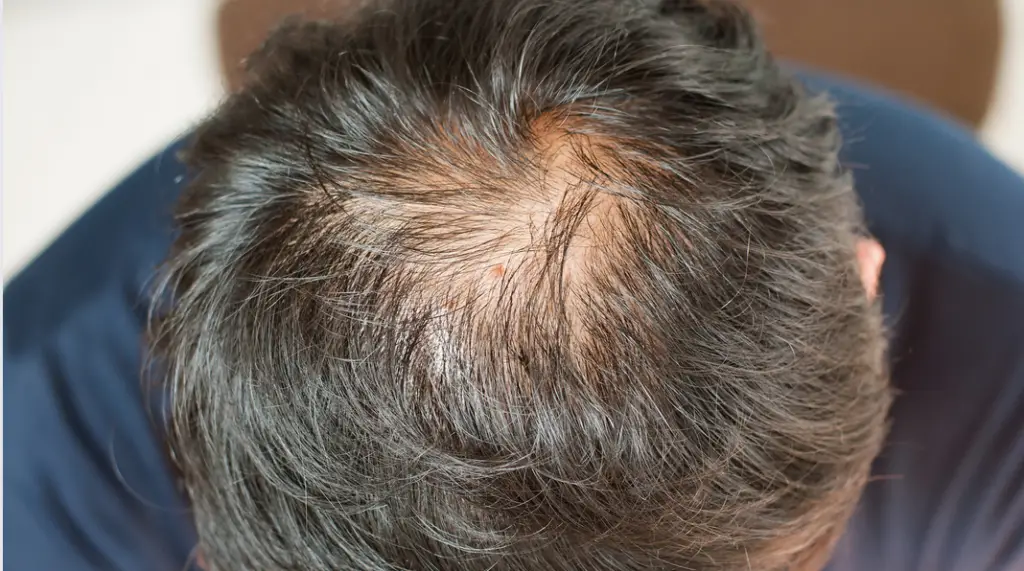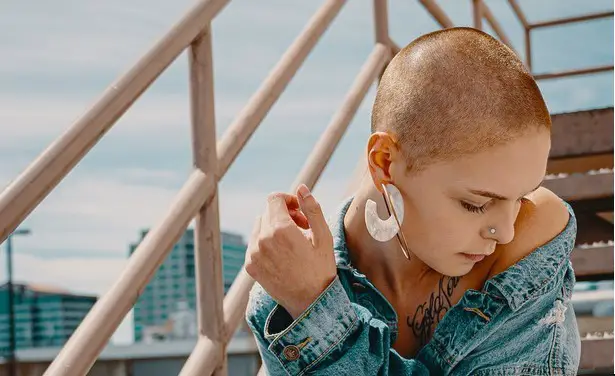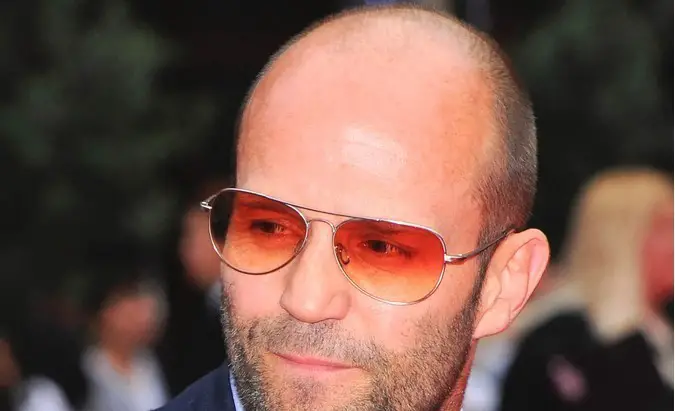Did you know? Male pattern baldness affects roughly 40 million men in the United States. According to the American Academy of Dermatology, two out of three men in this country develop some form of male baldness. In addition, roughly 20 million women are affected by hereditary-patterned baldness. If you’re experiencing hair loss, receding hairline, thinning, or balding and looking for natural, permanent hair restoration solutions, you’ve come to the right place!
What is Male Pattern Baldness?
About 95 percent of all cases of hair loss are the result of androgenetic alopecia (also known as male pattern baldness in men). Androgenetic alopecia occurs much more frequently in men than in women. It affects roughly 40 million men in the United States. Approximately 25 percent of men begin balding at 20 and by age 30; two-thirds begin balding by age 60.
While some types of hair loss are easily reversible, male pattern baldness is more permanent. It occurs in a characteristic pattern on the scalp: hair loss usually begins at the temples and at the top of the head toward the back, causing a receding hairline and a bald spot. Hair loss may continue until the two sections become joined, leaving a cul-de-sac hairline or a horseshoe-shaped area of hair on the sides and back of the head.
Male pattern baldness progresses slowly and is not associated with redness, itching, or pain. Currently, there is no way to prevent male pattern baldness from occurring.
What causes Male Pattern Baldness?
Male pattern baldness (or androgenetic alopecia) involves both hormonal (androgen) and genetic factors. Testosterone and its more potent derivative, dihydrotestosterone (DHT) …can cause hair follicles in the scalp to decrease in size later in life… Hair follicles become miniaturized, and the hair consequently becomes thinner and shorter. The growing phase of the growth cycle becomes progressively shorter, which means more hairs are shed.
Whatever the exact causes of male pattern baldness may be, it is a hereditary trait… A tendency toward baldness in men on either the mother’s or father’s side of a man’s family indicates a genetic predisposition to male baldness. The speed, pattern, time of onset, and degree of balding are all influenced by heredity. Generally, the earlier the onset of balding, the more extensive the degree of hair loss will eventually be.
Female Pattern Baldness
Female pattern baldness (female androgenetic alopecia) is the most common type of hair loss in women. According to the International Society of Hair Restoration Surgery, it occurs in about 20% of American women overall.
Female pattern baldness is similar to male pattern baldness in that it’s an inherited sensitivity to the effects of androgens (male hormones) on scalp hair follicles. However, the pattern of female baldness is different from the pattern seen in men. Female hair loss occurs primarily over the top and sides of the head and generally appears as thinning rather than total baldness.
Treatment for female pattern baldness is also similar to male pattern baldness. Options include hairpieces, laser therapy with minoxidil, or the more permanent solution of hair transplants.
Pattern Hair loss Treatment
Hair loss — Receding, thinning, balding, no matter how you phrase it, losing your hair can deflate one’s self-confidence. Hair loss limits your lifestyle, makes you feel older, and makes you scramble for solutions.
Hair loss Treatment Options
If you are uncomfortable with hair loss, you may want to consider one of the hair loss treatment options below:
Prescription Drugs
There are two drugs approved by the United States Food and Drug Administration (FDA) to treat male pattern baldness: Minoxidil and Finasteride (Propecia).
- Minoxidil: is used topically on the scalp. It may help hair to grow in 20 to 25% of the population, and in the majority, it may slow the loss of hair. Treatment is expensive, however, costing about $600 per year for the recommended twice-daily use. The higher concentration of minoxidil works better. Hair loss recurs when its use is discontinued.
- Finasteride: is the only oral medication that is approved by FDA for male pattern baldness. It inhibits the production of the hormone that contributes to male pattern baldness. About 50% of men who take this drug have increased hair growth in one year. In general, it is more effective than minoxidil. It has no major effect on testosterone levels in the body. About 2 percent of the men who take this drug experience sexual dysfunction.
Note that if prescription drugs are used as a hair loss treatment, they must be used without interruption for positive results.
Hair Transplants
Hair transplants consist of the removal of tiny plugs of hair from areas with natural hair growth (donor areas) and placing them in areas that are balding. When done properly, the affected area heals quickly, and hair growth resumes within a few months. Expert hair transplantation is a permanent hair loss treatment. Results are washable and look more natural than other treatments.
Hairpieces
Hair weaving, male or female pattern baldness hair extensions, hair topper for men, hairpieces, or a change of hairstyle may disguise hair loss. Synthetic hair can be custom-made, and hairpieces must be maintained by regular cleaning and tightening.
Laser cap therapy
Laser caps have been found to be effective in treating male pattern baldness. A 2019 study published in Lasers in Medical Science found that a Kiier laserCap and Irestore laser therapy helmet increased hair thickness and covered bald patches in men and women with androgenetic alopecia. Similarly, a 2018 review published in the journal, Lasers in Medical Science concluded that laser therapy “appears to be a safe, alternative treatment” for pattern hair loss.
The advantages of laser cap therapy are that it’s safe, effective, non-invasive, and completely painless. However, the disadvantages are that it’s time-consuming and may not be suitable for those with advanced stages of hair loss.
Additionally, the results of laser cap therapy may be temporary and may require regular treatments to maintain the results.
Male pattern baldness diet
While there is no definitive answer as to whether diet can affect male pattern baldness, some research suggests that a better diet may help slow the process. Taking supplements, biotin, vitamins, minerals, eating foods rich in raw vegetables and fresh herbs has been linked to a reduced risk of balding. Additionally, certain foods have been suggested to help reverse male pattern baldness, such as fatty fish like salmon, mackerel, tuna, anchovies, and other fatty fish; walnuts and almonds; flaxseed oil; bananas; chicken; almond butter; honey; spinach; coconut oil; and walnuts. However, it is important to note that these foods are not scientifically proven to reverse male pattern baldness.
Hair Loss Concealers
Hair loss concealers are the easiest, fastest thing you can do to reverse the appearance of male pattern baldness right now. One of the best things about hair loss concealers is that you can use them with hair growth drugs, hair transplants, and hair systems. They’re a powerful boost. They can also work magic all by themselves.
Concealers work in small bald areas and areas of thin hair. As you lose hair, your scalp begins to show through. You never really see hair loss. You begin to see the scalp. Hair loss concealers make your scalp vanish by coloring it to match your hair color. The better concealers also coat thin hairs and thicken them for remarkable fullness. The results are often hard to believe the first time you see them.
Will concealers block your follicles? No. The “blocked follicle” scam is the oldest one around. Fraudulent hair growth products are often peddled on the myth that hair loss is due to “blocked follicles.” Stay true to this. All hair loss occurs subdermally, beneath the layers of the skin. Hair loss concealers are all topical, resting on the surface of the skin where there is no interaction with the biology of hair growth.
Hair loss concealers fall into three general groups: solid, fiber, and spray. The solid is our clear choice. The solid concealer thickens hair and lifts them up. It stays on so well that you can swim with it, and it looks natural. See more details on the solid concealer. You can also see more on fiber and spray concealers.
Male pattern hair loss FAQ
To meet your concerns about hair loss or thinning hair, we’ve provided background info, educational resources, and answers to the most frequently asked questions about hair loss.
What are the hair growth and rest cycle?
On average, there are 100,000 to 150,000 hairs on the human scalp. The hairs grow from hair roots or follicles (saclike structures under the skin). Blood vessels at the base of each follicle provide the nourishment necessary for hair growth.
Hair growth in each root occurs in a cycle independent of the other roots. At any time, about 90 percent of the hairs on the scalp are in the growth phase, while the other 10 percent are in the resting phase. The growth phase lasts an average of four to five years, after which the follicle enters the resting phase, which lasts about two months to four months. At the end of the resting phase, the hair falls out naturally and is replaced by new hair.
Is some hair loss normal?
Some hair loss is a normal part of the hair growth cycle. In fact, on a typical day, about 50 to 150 scalp hairs are lost. Baldness (or alopecia) results when hair loss occurs at an abnormally high rate; when hair replacement occurs at an abnormally slow rate; or when normal hairs are replaced by thinner, shorter ones.
What does Male Pattern Baldness look like?
Male pattern baldness occurs in a characteristic pattern on the scalp: hair loss usually begins at the temples and at the top of the head toward the back, causing a receding hairline and a bald spot. Hair loss may continue until the two sections become joined, leaving a horseshoe-shaped area of hair on the sides and back of the head.
Here you can see the different stages of male pattern balding.
When does Male Pattern Baldness occur?
Balding may begin at any age after puberty, even in the middle teens, and can range from partial loss to complete baldness. Approximately 25 percent of men begin balding by age 30; two-thirds begin balding by age 60.
Is Male Pattern Baldness hereditary?
Whatever the exact causes of male pattern baldness may be, it is a hereditary trait A tendency toward baldness in men on either the mother’s or father’s side of a man’s family indicates a genetic predisposition to male baldness. The speed, pattern, time of onset, and degree of balding are all influenced by heredity. Generally, the earlier the onset of balding, the more extensive the degree of hair loss will eventually be.
What are some other types of hair loss?
Aside from male pattern baldness, some of the most common types of hair loss include:
Alopecia areata: which leads to patchy hair loss on the scalp. While the causes of alopecia areata are not completely understood, hair loss is thought to be the result of the body’s immune system attacking the hair follicle. Alopecia areata often resolves without treatment.
Traction alopecia: which results from long-term pulling on the hair. This type of hair loss can be caused by certain hairstyles, such as tight braids. The hair loss is usually reversible once the cause of this pulling is eliminated.
Certain diseases: such as diabetes, systemic lupus erythematosus, and disorders of the thyroid gland, can also cause baldness. Sudden hair loss may be an early warning sign for some diseases and should be reported to a doctor.
Hair loss has many other causes, including illness, poor nutrition, skin damage, some medications, and certain medical treatments such as anticancer chemotherapy and radiation therapy.
How is the cause of hair loss diagnosed?
Because there are many potential causes of excessive hair loss, consult a dermatologist if you are concerned. Your doctor will ask questions about your family’s history of baldness. They may also want to examine a few hairs under a microscope or check the scalp for signs of skin damage. You may be asked questions about your diet, hair-care procedures, medications (including vitamins and herbal supplements) that you take, and recent illnesses. In some cases, your doctor may order blood tests or a skin biopsy (taking a small sample of tissue for examination) to help make a diagnosis. They may also ask you to monitor the number of hairs lost during a day by collecting and counting as many as possible.
Hairloss Resources:
- American Academy of Dermatology
- American Society of Plastic Surgeons
- Medical Library, American Medical Association – Male pattern baldness
- Medline Plus Encyclopedia – Male pattern baldness
- Mayo Clinic Medical and Health Info – Baldness
- Merck Manual Home Edition – Hair Disorders
- American Hair Loss Council
- Int’l society of Hair Restoration Surgery
- AI Powered Bald Filter Online 2024: See Yourself with No Hair! - January 19, 2024
- Harklinikken Bad Reviews 2024: Analyzing Negative Feedbacks - January 18, 2024
- How to Get the Alex Eubank Hair | Step-By-Step Tutorial 2024 - January 18, 2024







